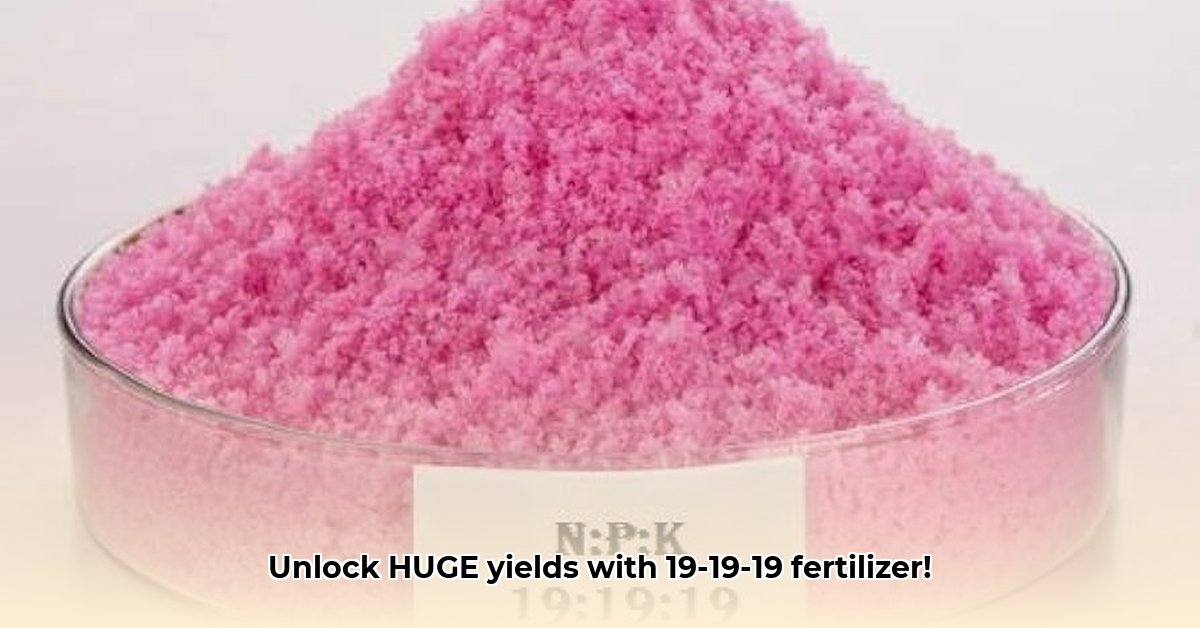
This guide provides practical advice on maximizing yields using 19-19-19 fertilizer, focusing on sustainable practices. While availability at Tractor Supply may vary, the principles discussed apply broadly to balanced NPK fertilizers and their sustainable alternatives. For more information on grass fertilizers from Tractor Supply, check out this helpful resource.
Understanding 19-19-19 Fertilizer
The numbers "19-19-19" represent the percentage by weight of nitrogen (N), phosphorus (P), and potassium (K) – essential nutrients for plant growth. Nitrogen fuels leafy growth; phosphorus supports root development and flowering; and potassium enhances plant strength and disease resistance. A 19-19-19 blend provides a balanced nutrient profile, suitable as a starter fertilizer for many crops. However, this doesn't always mean it's the best fertilizer for your needs.
Is 19-19-19 Right for Your Crops?
Before applying any fertilizer, a soil test is crucial. A soil test identifies nutrient deficiencies and excesses, guiding you toward the most effective fertilizer strategy. Over-fertilization wastes resources and can harm the environment. Different plants have different nutrient requirements, so a soil test tailored to your specific crop and soil type is essential.
Sustainable Fertilizer Application: A Step-by-Step Guide
Soil Testing: Obtain a soil test from your local agricultural extension office or a reputable soil testing laboratory. This will pinpoint your soil's nutrient composition and pH.
Fertilizer Selection: Based on the soil test and crop needs, determine the most appropriate fertilizer. While 19-19-19 might be suitable, a more targeted blend could be more effective and cost-efficient.
Application Rate: Follow the recommended application rate on the fertilizer packaging and/or instructions from your soil test analysis. Precision application techniques (e.g., controlled-release fertilizers or drip irrigation) can improve efficiency and minimize waste.
Application Method: Use a spreader for even coverage. Precision applicators allow for variable rate application, adjusting the amount applied based on soil nutrient needs.
Monitoring Plant Growth: Observe your plants' growth throughout the growing season. Yellowing leaves could indicate nitrogen deficiency, while stunted growth might signal phosphorus or potassium limitations.
Exploring Sustainable Alternatives to 19-19-19
While 19-19-19 effectively delivers nutrients, synthetic fertilizers can have environmental drawbacks. Runoff can pollute waterways, and they don't improve soil structure and health like organic methods do. Sustainable alternatives include:
- Compost: Improves soil structure and adds organic matter; nutrient content varies.
- Manure: Adds nutrients and improves soil structure; potential for weed seeds and pathogens if not composted properly.
- Cover Crops: Improve soil health, reduce erosion, and can fix nitrogen.
- Biofertilizers: Contain microorganisms that enhance nutrient uptake by plants.
Choosing a sustainable approach minimizes environmental impact and fosters long-term soil health.
Cost-Effectiveness: Beyond the Initial Price
The most cost-effective fertilizer considers yield, soil health, and environmental impact. While 19-19-19 may seem cheaper upfront, sustainable practices can lead to higher yields and reduced fertilizer needs over time. Organic options may initially cost more but provide long-term benefits by improving soil structure and reducing the need for future fertilizer applications.
Troubleshooting and FAQs
- Nutrient Deficiencies: Address deficiencies by adjusting fertilizer application based on your soil test and plant symptoms.
- Over-fertilization: Follow recommended application rates closely. Over-fertilization can damage plants and harm the environment.
- Environmental Concerns: Minimize runoff by applying fertilizer carefully, especially before rainfall. Implement conservation tillage and buffer strips to reduce environmental impact.
Resources
- Your local agricultural extension service: Offers soil testing, advice, and resources.
- USDA Natural Resources Conservation Service: Provides information on sustainable agricultural practices.
- [Link to relevant university extension website]: Provides research-based information on sustainable agriculture and nutrient management.
By implementing these strategies and prioritizing sustainable practices, you can maximize yields while safeguarding the environment for future generations. Remember, effective fertilization is a component of a holistic and sustainable agricultural approach.